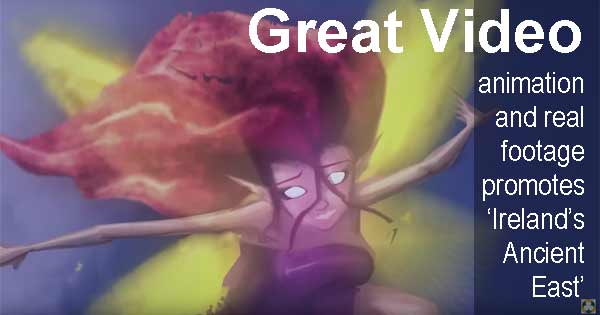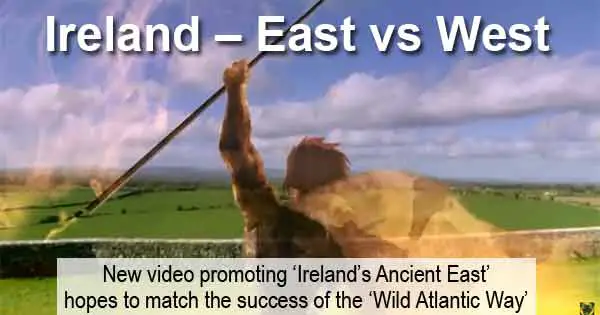The Irish tourist board have released a dramatic video to draw attention to Ireland’s ‘Ancient East’.
The video mixes magic and myths with the real history of the area to highlight the vast cultural heritage of the East of the country.
The tourist board hope that it will help be as successful as their campaign to promote the West of the country – including the Wild Atlantic Way.

They are hoping to attract over 600,000 more visitors to the east and south of Ireland by 2020. This could inject up to €1bn to into the local economy.
Tourism Minister Paschal Donohue says that currently 20% of tourists travel through the east and south during their stay but only 10% of tourism income goes into in those regions.
The video starts off with a fairy fluttering about, in a nod to some of the great traditional Irish myths.
However, for a brief moment the fairy turns nasty, before the video cuts to a modern image of some of the great natural scenery in the East of Ireland.
Animation is mixed with video footage to maximise the mystical feel. The narrator says: “Pagan gods roamed the earth. The kingdoms of Ireland were won and lost on the swing of a broad sword.”
The animation does more than just create a mystical feel, it also evokes the rich real life history that took place, such as the settlements, battles and daily life.
It hits home that people today are walking along the same streets or on the same land that has been walked on by people for hundreds or even thousands of years.
The sites in the initiative will be split into four groups –
Ancient Ireland, which will feature sites such as Newgrange and the Hill of Tara.
Early Christian Ireland, which includes ancient monasteries where monks worked and lived. Sites include Glendalough and the Hill of Slane, where St Patrick’s life was saved by a bonfire.
Medieval Ireland, which tells the tales of the Viking Invasion and early settlements. Waterford and Kilkenny are the key areas and the attractions include castles and the Rock of Cashel.
Anglo-Ireland, focuses on the period of the 18th and 19th centuries when the majority of Irish people were forced into poverty, while a minority who owned grand estates lived luxurious lifestyles.
These different groups will help visitors to understand how key periods of Ireland’s history including the monks, the Vikings, the Normans, the elite country homes and the Rebellions are all interlinked.
Mr Donohue says that the new initiative will target people over 30 who have an interest in culture and history.
He added: “The market research tells us there is potentially a lot more growth out there if we pitch our best assets to those segments with the most potential. With the great amount of history and heritage in such a relatively compact area, Ireland’s Ancient East will allow us to seriously build on the assets we have in the east and south, and the significant investment which has been made in tourism attractions in the region over the last few years.
“While appealing to a different type of a visitor, I am confident that Ireland’s Ancient East will prove as effective and popular as the Wild Atlantic Way and will, when brought to the overseas markets by Tourism Ireland and the tourism trade, deliver significant additional numbers of visitors, revenue and jobs to the region.”
Other initiatives include a ‘geo-location’ app that will tell users which sites are nearby.
Take a look at the promotional video for ‘Ireland’s Ancient East’.

More top attractions in Ireland
Galway named as one of the ‘best trips’ in the world by top American travel magazine
